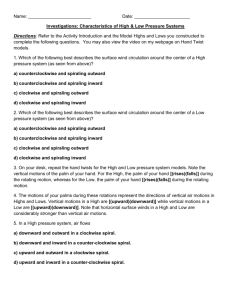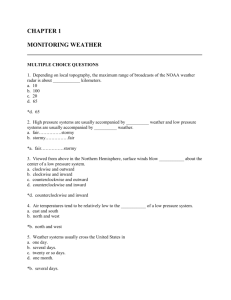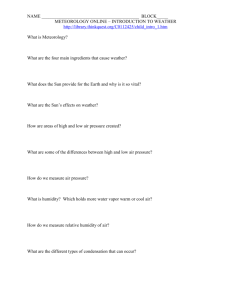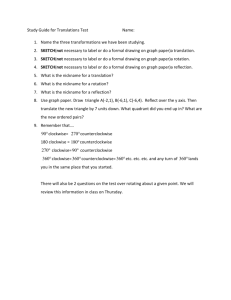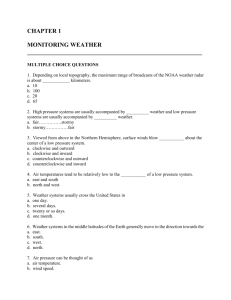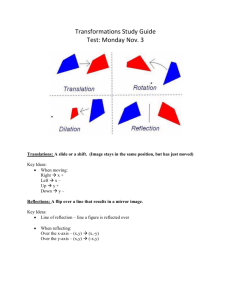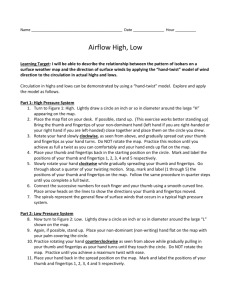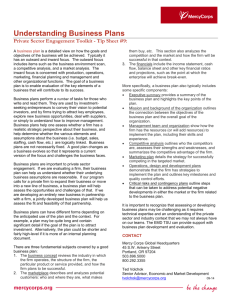Activity 4 Winds Around Highs and Lows Level 2
advertisement
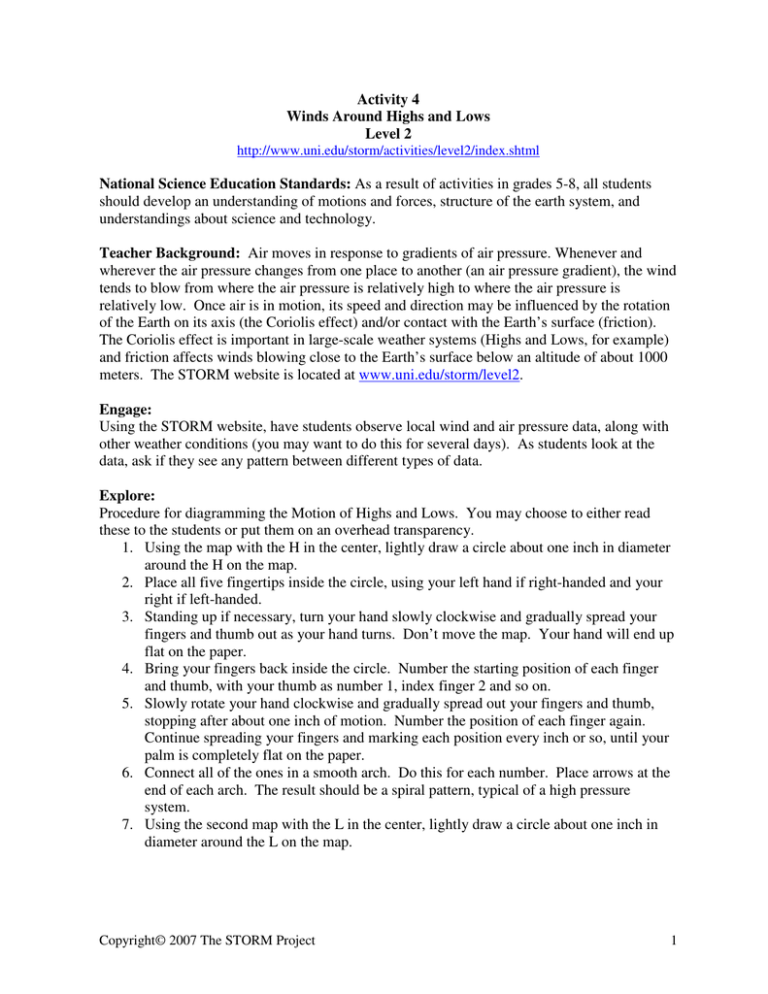
Activity 4 Winds Around Highs and Lows Level 2 http://www.uni.edu/storm/activities/level2/index.shtml National Science Education Standards: As a result of activities in grades 5-8, all students should develop an understanding of motions and forces, structure of the earth system, and understandings about science and technology. Teacher Background: Air moves in response to gradients of air pressure. Whenever and wherever the air pressure changes from one place to another (an air pressure gradient), the wind tends to blow from where the air pressure is relatively high to where the air pressure is relatively low. Once air is in motion, its speed and direction may be influenced by the rotation of the Earth on its axis (the Coriolis effect) and/or contact with the Earth’s surface (friction). The Coriolis effect is important in large-scale weather systems (Highs and Lows, for example) and friction affects winds blowing close to the Earth’s surface below an altitude of about 1000 meters. The STORM website is located at www.uni.edu/storm/level2. Engage: Using the STORM website, have students observe local wind and air pressure data, along with other weather conditions (you may want to do this for several days). As students look at the data, ask if they see any pattern between different types of data. Explore: Procedure for diagramming the Motion of Highs and Lows. You may choose to either read these to the students or put them on an overhead transparency. 1. Using the map with the H in the center, lightly draw a circle about one inch in diameter around the H on the map. 2. Place all five fingertips inside the circle, using your left hand if right-handed and your right if left-handed. 3. Standing up if necessary, turn your hand slowly clockwise and gradually spread your fingers and thumb out as your hand turns. Don’t move the map. Your hand will end up flat on the paper. 4. Bring your fingers back inside the circle. Number the starting position of each finger and thumb, with your thumb as number 1, index finger 2 and so on. 5. Slowly rotate your hand clockwise and gradually spread out your fingers and thumb, stopping after about one inch of motion. Number the position of each finger again. Continue spreading your fingers and marking each position every inch or so, until your palm is completely flat on the paper. 6. Connect all of the ones in a smooth arch. Do this for each number. Place arrows at the end of each arch. The result should be a spiral pattern, typical of a high pressure system. 7. Using the second map with the L in the center, lightly draw a circle about one inch in diameter around the L on the map. Copyright© 2007 The STORM Project 1 8. Place your non-writing hand, palm down, over the circle. Rotate your hand counterclockwise, bringing your thumb and fingers up into the circle. Practice this twisting motion, without moving the paper. 9. Place your palm down again, and number the position of each finger and thumb, with the thumb as number one. 10. Slowly rotate counterclockwise and gradually bring in your fingers and thumb, numbering the position of each finger after and inch or so of movement. 11. Connect each number in an arch, ending with an arrow pointed toward the L. This spiral pattern is typical of a low-pressure system. Explain: 1. Which of the following describes the surface wind circulation pattern around a High? A. Counterclockwise and outward. B. Counterclockwise and inward. C. Clockwise and outward. D. Clockwise and inward. 2. Which of the following describes the pattern of wind circulation around a Low? A. Counterclockwise and outward. B. Counterclockwise and inward. C. Clockwise and outward. D. Clockwise and inward. 3. On your desk, repeat the hand twists for the high and low pressure system models. For the High, the palm of your hand moves ______and for the Low, the palm of your hand moves __________. A. up. B. down. C. up. D. down. 4. The motions of your palm during the twisting represent the vertical motion of the air in Highs and Lows. Vertical motion in a High is downward, and vertical motion in a Low is _______________________. A. Downward B. Upward. 5. In a high pressure system, air flows A. downward and outward. B. upward and inward. 6. In a high pressure system, air moves A. clockwise. B. counterclockwise. Copyright© 2007 The STORM Project 2 7. In a low pressure system, air flows A. downward and outward. B. upward and inward. 8. In a low pressure system, air flows A. clockwise. B. counterclockwise. Answers: C, B, B & C, B, A, A, B, B Extend: 1. From the STORM website, have students click on the activity Winds Around Highs and Lows, then click on Current Wind Direction. They should study the map on the screen and try to identify areas of low pressure and areas of high pressure. What states, if any, have a high pressure over them? What states, if any, have a low pressure over them? Have them place L’s and H’s on the map below where they think there might be low and high-pressure systems. 2. Now have them click on the Current Surface Map. Study this weather map. How do the locations of Highs and Lows on this map compare to their answers above? For Further Inquiry: In the southern hemisphere winds circulate in the opposite direction around Highs and Lows, although they still move outward from high pressure and inward towards low pressure. Ask your students to redesign this activity so that it could be used in the southern hemisphere. Have them answer this challenge or any other question they might have about winds around Highs and Lows. Copyright© 2007 The STORM Project 3 Winds around Highs and Lows Student sheet Engage: At the activity website http://www.uni.edu/storm/activities/level2/, access the US Sky Cover and Winds map. Look for patterns that might show up on the map. You might wish to do this several days in a row and compare the maps. 1. From your observation and analysis, describe the types of patterns that appear to exist. ______________________________________________________________________ ______________________________________________________________________ Explore: Follow your teacher’s directions for determining wind direction around Highs and Lows using the H and L maps attached. Explain: 1. Which of the following describes the surface wind circulation pattern around a High? a. Counterclockwise and outward. b. Counterclockwise and inward. c. Clockwise and outward. d. Clockwise and inward. 2. Which of the following describes the surface wind circulation pattern around a Low? a. Counterclockwise and outward. b. Counterclockwise and inward. c. Clockwise and outward. d. Clockwise and inward. 3. Repeat the hand twists for the high and low pressure models. For the High, does the palm of your hand move up or down? _______ For the Low, does the palm of your hand move up or down? __________ 4. The motion of your palm during the twisting represents the vertical motion of the air in Highs and lows. Vertical motion of your palm for the high is downward. What is vertical motion of your palm for the Low? 5. In a high pressure system, air flows a. downward, counterclockwise and outward. b. upward, counterclockwise and inward. c. downward, clockwise and outward. d. downward, clockwise and inward. Copyright© 2007 The STORM Project 4 6. In a low pressure system, air flows a. downward, counterclockwise and outward. b. upward, counterclockwise and inward. c. downward, clockwise and outward. d. downward, clockwise and inward. Extend: On the activity website, click on the Current Wind Direction map. Study the map on the screen. Try to identify areas of low pressure and areas of high pressure. What states, if any, have a high pressure over them? What states, if any have a low pressure over them? Place L’s and H’s on the map below where you think there might be low and high pressure areas. Now click on the Current Surface Map. Study this weather map. 2. How do the locations of Highs and Lows on this map compare to your answers above? ______________________________________________________________________ Copyright© 2007 The STORM Project 5 Copyright© 2007 The STORM Project 6 Copyright© 2007 The STORM Project 7
